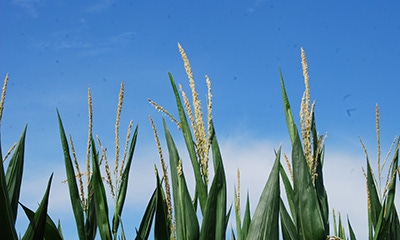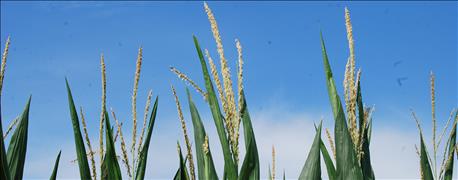July 12, 2016

In general, Iowa’s 2016 corn and soybean crops continue to make good progress statewide and their development remains ahead of the five-year average. The storm systems that have recently rolled across the state brought some needed moisture, but the storms also brought strong winds that caused isolated crop damage as well. That’s the summary of USDA’s latest weekly statewide crop survey, based on conditions for the week ending July 10.

THUNDERSTORMS: Needed rain fell across Iowa last week. South central and southeast remain the driest areas, with 49% of both regions rated very short to short on subsoil moisture as of July 10. Some farmers had isolated crop damage from high winds and hail.
For the most part, crops in Iowa are growing well and are in good condition, says WinField agronomist Tyler Steinkamp. The warm, wet weather patterns across the state in recent weeks have been optimal to prepare most fields for strong silk formation and healthy pollination. Cornfields began tasseling last week in southern Iowa, with corn in northern Iowa tasseling this week.
Corn pollination typically occurs over a 10-day period
Pollination typically occurs over a 10-day period in corn, so establishing good silk formation is essential, notes Steinkamp. Silk growth is best in hot, humid conditions, which will continue in the next couple weeks. Should humidity levels and temperatures drop too low, pollination and kernel formation may be compromised, he says.
Most soybeans flowered around June 20 in Iowa and last week they were in the R2 growth stage. Steinkamp has seen more nodes on plants this year than last year, and he predicts this will encourage a higher yield. Typically nodes 5 to 16 provide about 80% of the crop’s yield. He says there’s still potential for more nodes to develop, as soybeans will continue to flower as long as the weather allows.
Watch out for corn rootworm beetles, Japanese beetles
Moving into the next couple of weeks, Steinkamp encourages farmers to take tissue samples to identify the state of their crop’s nutrition. The next growth stages are optimal times to make applications of micronutrients. Micronutrient applications on corn, such as applying Boron and Zinc, are key at this stage to help in kernel development, to transfer sugars throughout the plant and to encourage healthy pollination, he says.
For soybeans, Boron and Manganese will be important for chlorophyll development and sugar distribution. Now is also a good time to watch for corn rootworm beetle and Japanese beetles in corn fields, as these insects can hinder pollination.
The complete weekly Iowa Crop Progress & Condition Report is available on the Iowa Department of Agriculture & Land Stewardship’s website IowaAgriculture.gov or on USDA’s site nass.usda.gov/ia. The report summary follows here:
Scattered reports of crop damage from strong winds, hail
CROP REPORT: Hit or miss rains allowed Iowa farmers 4.5 days suitable for fieldwork for the week ending July 10, 2016, according to USDA’s National Ag Statistics Service. Activities for the week included herbicide and insecticide applications to soybeans and farmers making their second cutting of hay. There were scattered reports of crop damage due to strong winds and hail.
Topsoil moisture levels rated 5% very short, 19% short, 72% adequate and 4% surplus. Subsoil moisture levels rated 4% very short, 17% short, 75% adequate and 4% surplus. South central and southeast Iowa were the driest areas of the Iowa with 49% rated short to very short on subsoil moisture.
Iowa’s corn crop now 29% silking; 40% of soybeans blooming
Twenty-nine percent of the Iowa corn crop had reached the silking stage as of July 10. Corn condition rated 79% good to excellent. Soybeans blooming reached 40%, two days ahead of both last year and the five-year average. In Iowa, 6% of soybeans were setting pods, four days ahead of normal. Soybean condition rated 77% good to excellent as of July 10. Nearly all of Iowa’s oat crop was headed. Oat acreage turning color reached 75%, with 16% of the oat crop harvested for grain or seed, four days ahead of last year. Statewide oat crop condition rating was unchanged from last week at 80% good to excellent.
Second cutting of alfalfa hay reached 67%, more than two weeks ahead of last year and 11 days ahead of the average. Third cutting of alfalfa hay got underway. Hay condition was rated at 72% good to excellent, while pasture condition rated 61% good to excellent. Livestock were generally reported to be in good condition, benefiting from cooler temperatures.
IOWA PRELIMINARY WEATHER SUMMARY—for week ended July 10, 2016
By Harry Hillaker, State Climatologist, Iowa Department of Agriculture & Land Stewardship
The crop reporting week began with a dry and unseasonably cool Fourth of July with daytime high temperatures mostly in the 70s. However, heat and humidity made a very rapid return on Tuesday (July 5) with highs in the mid-80s northeast to mid-90s in southwest Iowa. Highest humidity levels of the year pushed the heat index to 115 degrees F at Red Oak where the dew point reached an extremely high 84 degrees.
Storms brought rain to most of Iowa, some fields hit by wind
Thunderstorms brought rain to most of the east one-half of Iowa, plus west central Iowa, late on Tuesday and into Wednesday morning July 6. Heavy rain fell in east central Iowa with these storms where two to three inch amounts were common from Cedar Rapids to Clinton and Davenport. Wednesday was another very warm day but not nearly as humid as Tuesday with highs in the low 80s east to low 90s west.
Thunderstorms dampened nearly all of Iowa between Wednesday afternoon and Thursday morning. The Wednesday night rainfall brought ½ to 1½ inches of rain to almost all of Iowa, but largely missed east central Iowa where heavy rain fell the previous night. Additionally these storms brought numerous reports of high winds, especially in west central and north central Iowa. There were some scattered thunderstorms across the northwest one-half of Iowa on Thursday (July 7) afternoon with a few isolated reports of large hail. Dry weather with near-seasonal temperatures prevailed statewide on Friday and Saturday. Finally, showers and thunderstorms moved across about the northeast one-half of Iowa on Sunday (July 10) morning.
Iowa’s rain total last week was slightly above normal
Temperature extremes for the week varied from a Monday (July 4) morning low of 49 degrees at Elkader to a Tuesday (July 5) afternoon high of 95 degrees at Sidney. Temperatures for the week averaged slightly below normal northeast to slightly above normal southwest with a statewide average of 0.3 degrees below normal. Weekly rain totals varied from 0.62 inches at Orange City and 0.65 inches at Iowa City Airport to 4.14 inches at Lowden. The statewide average rain total was 1.71 inches while normal for the week is 1.07 inches.
You May Also Like




